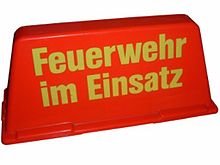Roof topper
A roof mount is a plastic sign that is attached to the car roof with magnets , suction cups or screws.
Roof mounts are available in different colors and shapes and with a wide variety of labels. It is used to inform, warn or as an advertising medium.
They are used in the following areas:
- Aid organizations such as the volunteer fire brigade , THW , civil protection , DRK , ASB , MHD , JUH , DLRG , water rescue service , etc. during an operation or the journey to the station / station
- Driving schools
- Taxis
- doctors
Roof-mounted by members of the fire brigade or aid organizations
Many firefighters and members of aid organizations use roof racks to mark their private vehicle during the trip to the fire station, for example . This marking can be helpful if special rights are claimed. Other road users then often voluntarily make room. A roof top does not create any rights of way, i. H. the other road users do not necessarily have to make room.
Flashing touch-ups or those with permanent light are generally not permitted here, but are often tolerated by the police.
In some districts, special permits can be issued for illuminated roof tops (mostly for first responders or helpers from on-site groups).
Doctors' roof toppers
Doctors are allowed to use roof attachments under certain conditions, this is regulated in the Road Traffic Licensing Regulations (StVZO) as follows:
"On motor vehicles in which a doctor is on the road to provide assistance in emergencies, a sign that looks forwards and backwards with the inscription" Doctor in emergency "on a yellow background may be affixed to the roof during use, the yellow one Emits flashing light; this only applies if the doctor is authorized to use the sign. Authorization to use the sign is granted by the approval office upon request; it decides after hearing the competent medical association. The authorized person receives a certificate about this, which must be carried with him during the mission and handed over to responsible persons for inspection upon request. "
Toppers for taxis
Carrying a roof sign is mandatory for taxis. In Germany, this is regulated as follows in the Ordinance on the Operation of Motor Vehicles in Passenger Transport (BOKraft):
"Taxis must be identified
2. by a sign (taxi sign) attached to the roof of the taxi across the direction of travel, illuminated from the inside and labeled 'Taxi' on the front and back as per Appendix 1."
Labeling, dimensions and type of lighting are regulated in Appendix 1 (§ 26 Paragraph 1 BOKraft) .
Further legal regulations
"(1) Only the prescribed lighting equipment that has been declared permissible may be attached to motor vehicles and their trailers. Luminous materials and reflective media are also considered to be lighting equipment. The lighting equipment must be properly and securely attached and always operational. Lighting equipment on motor vehicles and trailers, to which the Council Directive 76/756 / EEC of July 27, 1976 on the harmonization of the legal provisions of the member states on the installation of lighting and light signaling devices for motor vehicles and trailers (OJ EC No. L 262 P. 1), last amended by Commission Directive 91/663 / EEC of 10 December 1991 (OJ EC No. L 366 p. 17, OJ EC 1992 No. L 172 p. 87), must be within the angle specified in this guideline and be visible under the requirements specified there. "
The group of phosphors includes fluorescent, phosphorescent and self-luminous substances.
Which securing equipment has to be carried for broken down vehicles is specified in § 53a StVZO .
Due to the applicable regulations, other lighting equipment may not be used. Deviations from this can only be made in the event of a justifiable state of emergency according to Section 16 of the Administrative Offenses Act (OWiG). It must be checked and assessed in each individual case whether the relevant requirements are met:
"Anyone who commits an act in a present, not otherwise avertable danger to life, body, liberty, honor, property or another legal asset, in order to avert the danger from himself or another person, does not act unlawfully if, when weighing the conflicting interests, in particular the legal interests concerned and the degree of the threats threatening them, the protected interest substantially outweighs the impaired. However, this only applies if the action is an appropriate means of averting the danger. "
It must be proven that any other legal measure would not have served the same purpose.
Foils and signs that are not lighting equipment are permitted in any case.

